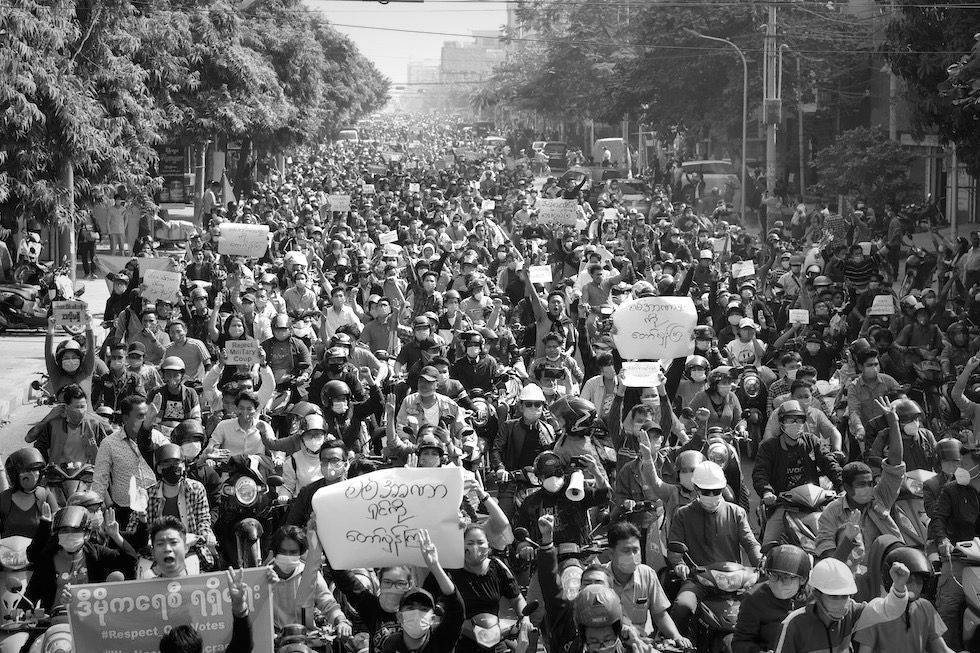Military rule in Myanmar started in 1962 with the first coup. From that time, successive military regimes launched a series of measures aimed at cultural homogenisation and the marginalisation of ethnic populations and areas. This strategy was, according to the analyst Siegfried Wolf, a means of ‘National Reconsolidation’ through repressive cultural policies that explicitly fostered the major ethnic group of the country, the Bamar, and conflated state-building with Bamar-centric nation-building. The spread of social media since 2011 gave the military and other actors in Myanmar a powerful means to manipulate public opinion, contributing to incite violence against ethnic minorities. It is 2021, almost 60 years later from the first coup, and it seems nothing has really changed. Since February 1st – when the current turmoil started with the latest military-led coup and the arrest of Daw Aung San Suu Kyi – protesters have repeatedly taken to the streets, involving also inter-ethnic movements demanding federal democratic reforms. This has recalled the issue of ethno-national discrimination of minorities by state apparatuses and the Bamar ethnic majority, intensified through the use of social media channels. It was also a reminder that the semi-democratic transition that started in the second half of the 2000s was not necessarily an improvement for many populations, especially in the border areas.
This is particularly evident for what regards the Rohingya community, a Muslim ethnic group mostly based in the coastal state of Rakhine, in the west of Myanmar. This minority, throughout the years, has been frequently depicted by Bamar-dominated state institutions and Rakhine nationalists as a threat to the security of the Union. The Rohingya population has been facing systematic oppression by the state of Myanmar since the 1970s, but their plight came to the world’s attention dramatically after their persecution by the Myanmar government in 2017. According to The Economist, in those circumstances, the Tatmadaw (Myanmar Armed Forces) sacked Rohingya villages, killed at least 10,000 people, and forced at least 720,000 to flee to neighbouring Bangladesh. The violent acts were publicly criticized by UN official representatives that defined this military campaign as a ‘potential genocide’ and as an example of ‘ethnic cleansing’.
Several interconnected factors contributed to the process of ‘othering’ through which the existence of this ethnic minority has been progressively rejected: disparate narratives concerning the arrival of this community in Myanmar, the denial of their right to citizenship as a result of the 1982 Citizenship Law, and the discriminatory laws adopted between 2014 and 2015 are just some of the historical, normative and social elements that constituted a breeding ground for shaping a discriminatory landscape. Notwithstanding, among the various dynamics at work to legitimise the atrocities committed by the military forces against the Rohingya, some are often underestimated. One of them is the prominent role played by the sudden shift experienced by the Myanmar media environment.
During the military government period, in fact, Myanmar had one of the world’s most inflexible and restricted media environments, and public political expression was severely downsized. The first policies of media liberalization and media landscape freedoms were granted in 2011. The Internet’s arrival in the country had for some ethnic-minorities, such as the Rohingya, more critical outcomes and undesirable political consequences than beneficial implications. This is confirmed by the journalist Hereward Holland who recognizes how those media freedoms granted chances for divisive voices to foment an ethnic and religious conflict that had long been suppressed by Myanmar’s military-led government. The abrupt and massive utilization of digital tools such as social media rendered cheaper, faster, and more effective in their wide-reach results the spread of extreme speech against these minorities. These practices were in part worsened by low levels of media-literacy throughout the Union, with large part of the populations having scarce tools to distinguish real information from disinformation and propagandistic narratives. Such intertwined factors rendered the Internet a weapon of great potential that was employed also vis à vis Rohingya communities.
Through these channels, tactics of post-truth politics, were extensively adopted to spread extreme hate-speech and wilful lies aimed at the criminalization and vilification of Rohingya. They were frequently portrayed as economic competitors, ‘illegal Bengali immigrants’, ‘pests’, ‘dogs’, and even, generalizing, as a group of ‘Islamist extremists’. These discriminatory discourses were spread both by official Myanmar authorities as well as by influential religious nationalists groups such as the anti-Muslim 969 Movement and the Ma Ba Tha, whose leader is the Buddhist monk Ashin Wirathu, an assiduous user of social media. The monk was portrayed on the cover of the TIME magazine of July 2013 as “The Face of Buddhist Terror”. In that circumstance, the former President of Myanmar Thein Sein strongly supported the Buddhist monk, upholding the mutual relations between the central authorities, Buddhist clerics and the military components, defined by Siegfried Wolf as the “state-temple alliance”.
Similarly, social networks were employed with the same purpose by members of the Myanmar military. This has been confirmed by Facebook itself, as reported by the New York Times article, arguing that military components “were the prime operatives behind a systematic campaign on Facebook that (...) targeted the country’s mostly Muslim Rohingya minority group”. In this regard, according to researcher Ronan Lee, the persecution suffered by the Rohingya and the horrors committed in the military campaign of 2017 demonstrated how extreme speech perpetrated by influential authorities against a specific minority can generate devastating real-world consequences when such speech has been made acceptable and mainstreamed.
In such a context, it would be misguided to take a simplified reading of the recent Myanmar coup as a dispute between the National League for Democracy against Tatmadaw. The peaceful protests started after the 1st of February saw various ethnic nationalities together claiming their rights in a very promising and potentially transformational manner. In the general political turbulence of actual Myanmar, the histories, meanings, values, and potentialities of ethnicity as a political capital should not be forgotten and set aside. While the first post-coup of 1962 saw the plight of Rohingya and other ethnic groups worsen, the post 01.02.2021 coup possibly foregrounds alternative outcomes.
Cover photo: (C) AP, massive anti-coup protest in Yangon, 7 Feb 2021.

